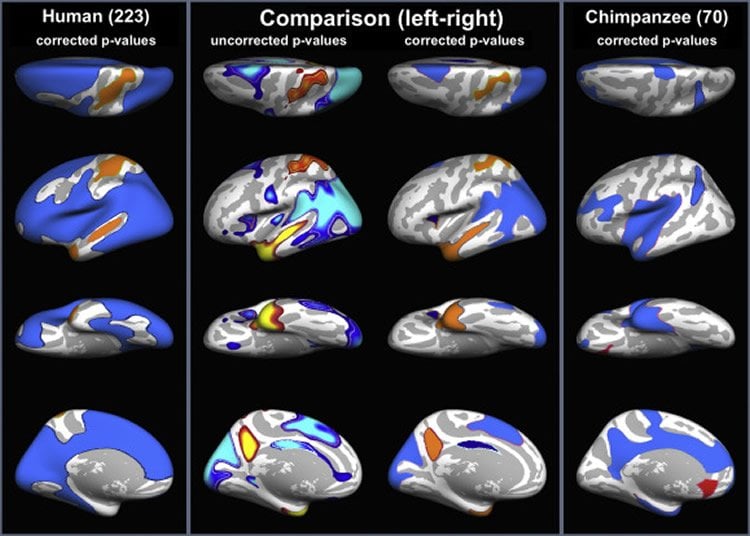Summary: A new neuroimaging study reveals patterns of asymmetry in the human brain may be unique to our species and could help explain how we developed language skills.
Source: University of Edinburgh.
The pattern of asymmetry in human brains could be a unique feature of our species and may hold the key to explaining how we first developed language ability, experts say.
Findings are based on brain scans of humans and previously collected data from chimpanzees. They could help scientists understand how our brains evolved and why asymmetry is vital to human development.
The study explores the phenomenon of brain torque, in which the human brain shows slight twisting. Until now, this was also thought to be true of other primates.
Researchers led by the University of Edinburgh studied images from an existing bank of chimpanzee brain scans held in the US.
Comparisons were made with the brains of humans who were scanned using similar equipment – known as magnetic resonance imaging (MRI) – and identical experimental procedures.
Chimpanzee brains were shown to be made up of equal halves, or hemispheres, whereas in human brains a subtle twist was present.

Asymmetry was seen in humans – but not chimpanzees – with the left hemisphere longer than the right.
Language ability has been linked to areas within the left hemisphere of the brain and has also been associated with asymmetry.
The research sheds light on how humans developed skills for language, researchers suggest. A new study of particular brain areas related to language using the same image bank could aid understanding of this.
Neil Roberts, Professor of Medical Physics and Imaging Science at the University of Edinburgh, said: “Our findings highlight a special, subtle feature of the human brain that distinguishes us from our closest primate cousins and may have evolved rapidly. Better understanding of how this came about in our evolution could help explain how humans developed language.”
The study was published in the journal NeuroImage. It was carried out in collaboration with researchers at the University of Oxford, as well as in China and the US.
Source: Kate McAllister – University of Edinburgh
Publisher: Organized by NeuroscienceNews.com.
Image Source: NeuroscienceNews.com image is credited to Roberts et al./NeuroImage.
Original Research: Full open access research for “Human torque is not present in chimpanzee brain” by Xiang Li, Timothy J. Crow, William D. Hopkins, Qiyong Gong, and Neil Roberts in NeuroImage. Published online October 17 2017 doi:10.1016/j.neuroimage.2017.10.017
[cbtabs][cbtab title=”MLA”]University of Edinburgh “Chimp Study Reveals How Brain’s Structure Shaped Our Evolution.” NeuroscienceNews. NeuroscienceNews, 15 November 2017.
<https://neurosciencenews.com/evolution-chimp-neuroanatomy-7948/>.[/cbtab][cbtab title=”APA”]University of Edinburgh (2017, November 15). Chimp Study Reveals How Brain’s Structure Shaped Our Evolution. NeuroscienceNews. Retrieved November 15, 2017 from https://neurosciencenews.com/evolution-chimp-neuroanatomy-7948/[/cbtab][cbtab title=”Chicago”]University of Edinburgh “Chimp Study Reveals How Brain’s Structure Shaped Our Evolution.” https://neurosciencenews.com/evolution-chimp-neuroanatomy-7948/ (accessed November 15, 2017).[/cbtab][/cbtabs]
Abstract
Human torque is not present in chimpanzee brain
We searched for positional brain surface asymmetries measured as displacements between corresponding vertex pairs in relation to a mid-sagittal plane in Magnetic Resonance (MR) images of the brains of 223 humans and 70 chimpanzees. In humans deviations from symmetry were observed: 1) a Torque pattern comprising right-frontal and left-occipital “petalia” together with downward and rightward “bending” of the occipital extremity, 2) leftward displacement of the anterior temporal lobe and the anterior and central segments of superior temporal sulcus (STS), and 3) posteriorly in the position of left occipito-temporal surface accompanied by a clockwise rotation of the left Sylvian Fissure around the left-right axis. None of these asymmetries was detected in the chimpanzee, nor was associated with a sex difference. However, 4) an area of cortex with its long axis parallel to the olfactory tract in the orbital surface of the frontal lobe was found in humans to be located higher on the left in females and higher on the right in males. In addition whereas the two hemispheres of the chimpanzee brain are equal in extent in each of the three dimensions of space, in the human brain the left hemisphere is longer (p = 3.6e-12), and of less height (p = 1.9e-3), but equal in width compared to the right. Thus the asymmetries in the human brain are potential correlates of the evolution of the faculty of language.
“Human torque is not present in chimpanzee brain” by Xiang Li, Timothy J. Crow, William D. Hopkins, Qiyong Gong, and Neil Roberts in NeuroImage. Published online October 17 2017 doi:10.1016/j.neuroimage.2017.10.017






